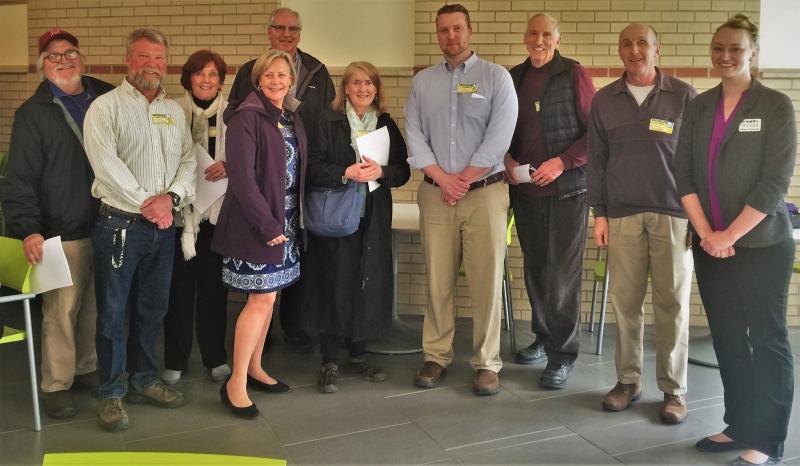Road trip: Boothbay region group views Farmington school program
Boothbay region members of the Education and Regional Workforce Opportunities Committee (ERWOC) visited Mount Blue High School in Farmington April 26. The nine members – Alternative Organizational Structure (AOS) 98 administrators, Rotary Club volunteers, and representatives of Congregational Church of Boothbay Harbor and the Boothbay Harbor Region Chamber of Commerce – toured the skills-based, Foster Career and Technology Center.
Under the guidance of Chamber Executive Director Patricia Royall and Community Resources Council board member Holly Stover, ERWOC arranged the tour and presented it to the CSD School Committee on March 28. Royall explained ERWOC wants to learn about some of the best examples of educational and vocational training in Maine and see how they can be applied locally.
Franklin County Adult Education Director Glenn Kapiloff said the program mixes throughout the campus, among traditional classrooms like math, English and science.
The campus tour featured the classrooms and workspaces for all the programs, including automotive, biotechnology, building construction, business, CNA certification and training, commercial arts and photography, composites, computer technology, criminal justice, culinary arts, digital media, early childhood occupations, firefighting, forestry and wood harvesting, metal fabrication, plumbing, pre-engineering, and computer-aided drafting and design. MBHS also has its own branch of Franklin Savings Bank where students can do internships.
Foster Tech serves Mount Blue, Mount Abram, Spruce Mountain, and Rangeley Lakes Regional high schools. The programs are geared mostly toward juniors and seniors as well as adults in the community, but are attempting to serve students as young as 13 with career exploration programs for grades eight and nine.
Kapiloff said technical programs like Foster Tech are funded through tax dollars, but often begin with private donations or awards. If a program can be created and maintained for two years – usually through local taxes or private funds – the state will continue to fund it, he said.
For example, Maine Attorney General Janet Mills wanted plumbing programs to receive some of the funds resulting from a lawsuit involving illegal plumbing in Portland. She approached Foster Tech and Kapiloff explained it did not have a plumbing program. Able to work out a budget of $60,000 per year for two years to build a program, Kapiloff notified Mills, who then awarded Foster Tech the funds.
“When somebody from the outside comes in and says ‘I’ll fund you for two years,’ it’s an easy thing to say we’re going to use the budget and we’ve got money to offset it, and two years from now it will become perpetual,” Kapiloff said.
Kapiloff said sometimes it is a difficult sell to local voters who question if they will be paying for it in their state taxes, but he has convinced many voters by explaining the funds will go somewhere if not Foster Tech and MBHS.
“It’s an investment in the community, not just in education,” Rev. Dr. Sarah Foulger of Congregational Church of Boothbay Harbor said.
Kapiloff agreed, saying the state will not only continue to fund a sustainable program, but occasionally will fund it over 100 percent. The state funds one of the school’s newest programs at nearly 102 percent, he said.
Boothbay Region High School Principal Dan Welch wanted to see how Foster Tech and MBHS integrated their programs with community members. “I wanted to see how they melded and balanced offerings for high school students and for adults.” His takeaway was that Foster Tech has some programs and methods of integration that could be molded to BRHS and to the community’s larger needs.
“I also took away that there is a lot of energy around the Boothbay Region right now to further explore how we can provide education and training opportunities for our (community members).”
Royall said the ERWOC members wanted to learn about MBHS and Foster Tech’s success firsthand and to bring administrators from the CSD to see if a similar model could be built in the Boothbay region. “The first thing that struck me about Mt. Blue was seeing happy and engaged students everywhere we went. They were friendly, polite and eager to share their experiences with us. It's quite obvious they are extremely proud of their school.”
According to Royall, the tour helped members envision the potential for a smaller scale version of Foster Tech. Royall also pointed out that much of Foster Tech’s success comes from the engagement of local businesses and tradesmen who assist the program through funding, supplies and teaching. “This kind of model has the ability to transform this community's future by providing the necessary job skills to fulfill our local employers’ needs and attract and keep young people in our region.”































